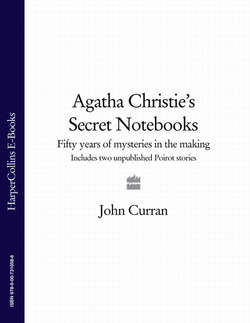Читать книгу Agatha Christie’s Secret Notebooks: Fifty Years of Mysteries in the Making - Includes Two Unpublished Poirot Stories - John Curran - Страница 39
Surprise, Surprise!
ОглавлениеBut the most unexpected element in the Notebooks was, to me, the fact that many of Christie’s best plots did not necessarily spring from a single devastating idea. She considered all possibilities when she plotted and did not confine herself to one idea, no matter how good it may have seemed. In very few cases is the identity of the murderer a given from the start of the plotting.
The most dramatic example is Crooked House (see also Chapter 4). With its startling revelation that the killer is a child, it remains one of the great Christie surprises, in the same class as The Murder of Roger Ackroyd, Murder on the Orient Express, Curtain and Endless Night. (To be entirely fair, at least two other writers, Ellery Queen in The Tragedy of Y and Margery Allingham in The White Cottage Mystery had already exploited this idea but far less effectively.) At that stage she had already used the narrator-murderer gambit, the police-man-murderer gambit, the everybody-did-it gambit, the every-body-as-victim gambit. Before reading the Notebooks, I had visualised Agatha Christie at her typewriter smiling craftily as she sat down in 1948 to write the next ‘Christie for Christmas’ and weaving a novel around the device of an 11-year-old girl as a cold-blooded murderer. Not so, however. Even a cursory glance at Notebook 14 shows that Christie considered Sophia, Clemency and Edith as well as Josephine when it came to potential murderers. It was not a case of arranging the entire plot around Josephine as the one unalterable fact. It was not the raison d’être of this novel; the shattering identity of the murderer was only one element under consideration and not necessarily the key element.
Again, at no point in the notes for her last devastating surprise, Endless Night (see Chapter 12), is there mention of the narrator-killer. It was not a case of thinking ‘I’ll try the Ackroyd trick again but this time with a working-class narrator. And I’ll begin with the meeting and courtship, which is all part of the plot, rather than after the marriage.’ Indeed, there is brief mention in Notebook 50 of one of the characters being a friend of Poirot, who was, presumably, to investigate the case; and at only one point is there mention of telling the story in the first person. The inspiration for the shock ending came to her as she plotted rather than the other way round.
Arguably the last of the ingeniously clued detective novels, A Murder is Announced (see Chapter 5), would seem to allow of only one solution, and yet at one stage Letitia Blacklock is pencilled in as the second victim of Mitzi, who has already murdered her own husband Rudi Sherz. It was not a case of deciding to write a novel featuring a supposed victim actually murdering her blackmailer during a carefully devised game. Nor did Murder in Mesopotamia (see Chapter 8) begin life featuring a wife-killing husband with a perfect alibi; she also considered Miss Johnston and, in fact, Mrs Leidner herself was a strong contender for the role of killer for much of the plotting. The setting, the archaeological dig, would seem to have been the fixed idea for this novel and the rest of the plot was woven around it rather than vice versa.
Although this still seems surprising, it is in keeping with her general method of working. Her strengths lay in her unfettered mental fertility and her lack of system. Her initial inspiration could be as vague as a gypsy’s curse (Endless Night), an archaeological dig (Murder in Mesopotamia) or a newspaper advertisement (A Murder is Announced). After that, she let her not inconsiderable imagination have free rein with the idea and hey, presto! a year later the latest Christie appeared on the bookshelves. And some of the ideas that did not make it into that masterpiece might well surface in the one to be published the following year—or ten years hence.
We now have a clearer idea of Christie’s approach to the construction of her stories. Using the Notebooks as a combination of sounding board and literary sketchpad, she devised and developed; she selected and rejected; she sharpened and polished; she revisited and recycled. And, as I hope to show by a more detailed analysis in the following chapters, out of this seeming chaos she produced a unique and immortal body of work.
